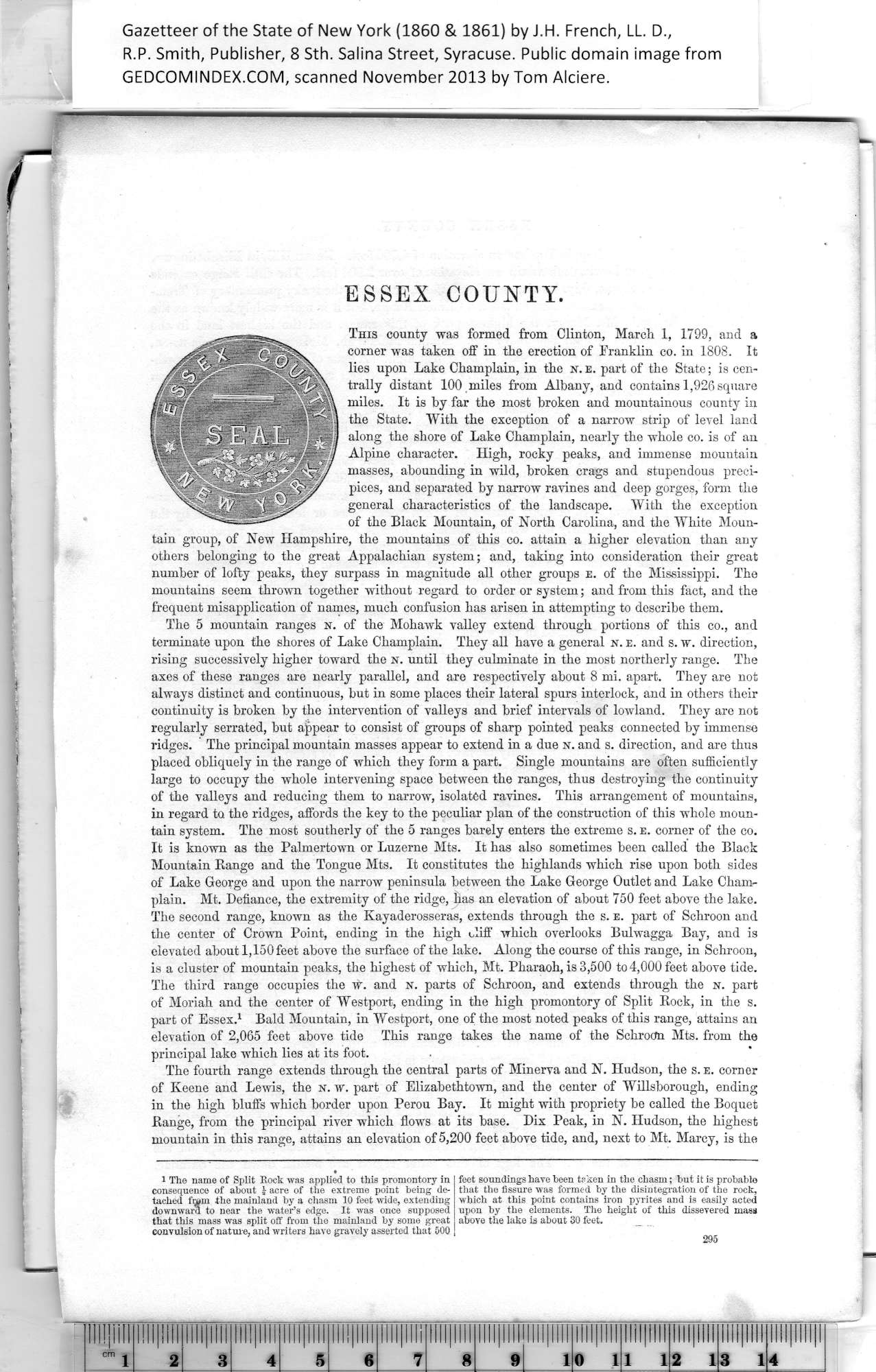|
ESSEX COTJXTY.
This county was formed from Clinton, March 1, 1799, and a
corner was taken off in the erection of Franklin co. in 1808. It
lies upon Lake Champlain, in the N. e. part of the State; is cen¬
trally distant 100 miles from Albany, and contains 1,926 square
miles. It is by far the most broken and mountainous county in
the State. With the exception of a narrow strip of level land
along the shore of Lake Champlain, nearly the whole co. is of an
Alpine character. High, rocky peaks, and immense mountain
masses, abounding in wild, broken crags and stupendous preci¬
pices, and separated by narrow ravines and deep gorges, form the
general characteristics of the landscape. With the exception
of the Black Mountain, of North Carolina, and the White Moun¬
tain group, of New Hampshire, the mountains of this co. attain a higher elevation than any
others belonging to the great Appalachian system; and, taking into consideration their great
number of lofty peaks, they surpass in magnitude all other groups e. of the Mississippi. The
mountains seem thrown together without regard to order or system; and from this fact, and the
frequent misapplication of names, much confusion has arisen in attempting to describe them.
The 5 mountain ranges n. of the Mohawk valley extend through portions of this co., and
terminate upon the shores of Lake Champlain. They all have a general n. e. and s. w. direction,
rising successively higher toward the n. until they culminate in the most northerly range. The
axes of these ranges are nearly parallel, and are respectively about 8 mi. apart. They are not
always distinct and continuous, but in some places their lateral spurs interlock, and in others their
continuity is broken by the intervention of valleys and brief intervals of lowland. They are not
regularly serrated, but appear to consist of groups of sharp pointed peaks connected by immense
ridges. The principal mountain masses appear to extend in a due n. and s. direction, and are thus
placed obliquely in the range of which they form a part. Single mountains are often sufficiently
large to occupy the whole intervening space between the ranges, thus destroying the continuity
of the valleys and reducing them to narrow, isolated ravines. This arrangement of mountains,
in regard to. the ridges, affords the key to the peculiar plan of the construction of this whole moun¬
tain system. The most southerly of the 5 ranges barely enters the extreme s. e. comer of the co.
It is known as the Palmertown or Luzerne Mts. It has also sometimes been called the Black
Mountain Range and the Tongue Mts. It constitutes the highlands which rise upon both sides
of Lake George and upon the narrow peninsula between the Lake George Outlet and Lake Cham¬
plain. Mt. Defiance, the extremity of the ridge, lias an elevation of about 750 feet above the lake.
The second range, known as the Kayaderosseras, extends through the s. e. part of Schroon and
the center of Crown Point, ending in the high cliff which overlooks Bulwagga Bay, and is
elevated about 1,150 feet above the surface of the lake. Along the course of this range, in Schroon,
is a cluster of mountain peaks, the highest of which, Mt. Pharaoh, is 3,500 to 4,000 feet above tide.
The third range occupies the w. and n. parts of Schroon, and extends through the n. part
of Moriah and the center of Westport, ending in the high promontory of Split Rock, in the s.
part of Essex.1 Bald Mountain, in Westport, one of the most noted peaks of this range, attains an
elevation of 2,065 feet above tide This range takes the name of the Schrocfn Mts. from the
principal lake which lies at its foot.
The fourth range extends through the central parts of Minerva and N. Hudson, the s. e. corner
of Keene and Lewis, the n. w. part of Elizabethtown, and the center of Willsborough, ending
in the high bluffs which border upon Perou Bay. It might with propriety be called the Boquet
Range, from the principal river which flows at its base. Dix Peak, in N. Hudson, the highest
mountain in this range, attains an elevation of 5,200 feet above tide, and, next to Mt. Marcy, is the
|
feet soundings have been taken in the chasm; but it is probable
that the fissure was formed by the disintegration of the rock,
which at this point contains iron pyrites and is easily acted
upon by the elements. The height of this dissevered mass
above the lake is about 30 feet. _ |
295
1
The name of Split Rock was applied to this promontory in
consequence of about J acre of the extreme point being de¬
tached frpm the mainland by a chasm 10 feet wide, extending
downward to near the water’s edge. It was once supposed
that this mass was split off from the mainland by some great
convulsion of nature, and writers have gravely asserted that 500
|
